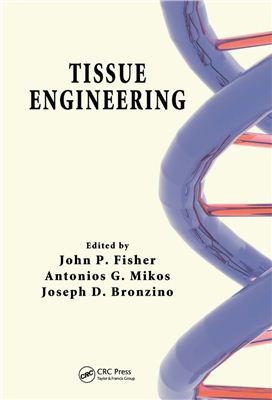CRC Press Taylor and Francis Group, Library of Congress
cataloging-in-Publication Data, ISBN-10:0-8493-9026-5
Increasingly viewed as the future of medicine, the field of tissue engineering is still in its infancy. As evidenced in both the scientific and popular press, there exists considerable excitement surrounding the strategy of regenerative medicine. To achieve its highest potential, a series of technological advances must be made.
Putting the numerous breakthroughs made in this field into a broad context, Tissue Engineering disseminates current thinking on the development of engineered tissues. Divided into three sections, the book covers the fundamentals of tissue engineering, enabling technologies, and tissue engineering applications. It examines the properties of stem cells, primary cells, growth factors, and extracellular matrix as well as their impact on the development of tissue engineered devices. Contributions focus on those strategies typically incorporated into tissue engineered devices or utilized in their development, including scaffolds, nanocomposites, bioreactors, drug delivery systems, and gene therapy techniques.
Finally, the book presents synthetic tissues and organs that are currently under development for regenerative medicine applications. The ability to engineer biocompatible tissue is the hallmark of mode biomedical engineering, integrating all aspects of every sub-discipline in the field. Featuring chapters drawn from the third edition of the best-selling Handbook of Biomedical Engineering as well as new contributions not found in the handbook, Tissue Engineering surveys the latest advances in this relatively young area. The contributing authors are a diverse group with backgrounds in academia, clinical medicine, and industry.
Furthermore, the text includes contributions from Europe, Asia, and North America, helping to broaden the views on the development and application of tissue engineered devices
Increasingly viewed as the future of medicine, the field of tissue engineering is still in its infancy. As evidenced in both the scientific and popular press, there exists considerable excitement surrounding the strategy of regenerative medicine. To achieve its highest potential, a series of technological advances must be made.
Putting the numerous breakthroughs made in this field into a broad context, Tissue Engineering disseminates current thinking on the development of engineered tissues. Divided into three sections, the book covers the fundamentals of tissue engineering, enabling technologies, and tissue engineering applications. It examines the properties of stem cells, primary cells, growth factors, and extracellular matrix as well as their impact on the development of tissue engineered devices. Contributions focus on those strategies typically incorporated into tissue engineered devices or utilized in their development, including scaffolds, nanocomposites, bioreactors, drug delivery systems, and gene therapy techniques.
Finally, the book presents synthetic tissues and organs that are currently under development for regenerative medicine applications. The ability to engineer biocompatible tissue is the hallmark of mode biomedical engineering, integrating all aspects of every sub-discipline in the field. Featuring chapters drawn from the third edition of the best-selling Handbook of Biomedical Engineering as well as new contributions not found in the handbook, Tissue Engineering surveys the latest advances in this relatively young area. The contributing authors are a diverse group with backgrounds in academia, clinical medicine, and industry.
Furthermore, the text includes contributions from Europe, Asia, and North America, helping to broaden the views on the development and application of tissue engineered devices

